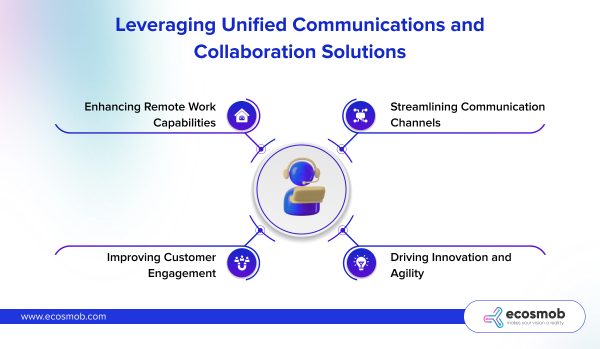QUICK SUMMARY
Discover how secure Unified Communications revolutionizes healthcare communication, ensuring HIPAA compliance and robust patient data security. Dive into this insightful blog on the importance of security in healthcare UC.
Cloud-based Unified Communications (UC) is a relatively new technology that is gaining traction among enterprises. Even small businesses are cautiously moving to the cloud as the Unified Communications as a Service (UCaaS) sector rapidly enters the mainstream. However, many IT teams are concerned about the possible hazards associated with cloud migration. Migrating to a Unified Communications system can be transformative, offering a unified voice, video, messaging, and file-sharing platform. However, UC migration presents its own set of challenges that require strategic planning and execution. In this blog, we will delve into the essential best practices for UC migration and discuss how to ensure a secure UC migration.
According to mordorintelligence, the Unified Communications and Collaboration market size is estimated at USD 145.58 billion in 2024. It is expected to reach USD 496.30 billion by 2029, growing at a CAGR of 27.80% during the forecast period (2024-2029).
Challenges of UC Migration
Before you embark on your UC migration journey, it’s crucial to acknowledge and prepare for the potential hurdles. One of the main challenges lies in the complexity of existing IT infrastructures. Businesses often operate on a mix of old and new technologies, which can complicate the integration of Unified Communications and Collaboration solutions. Additionally, ensuring data security during the transition is paramount to protect sensitive information from cyber threats.
Integration with Existing Systems
Integrating new UC infrastructure with legacy systems is one of the most significant challenges. These older systems may need to support the latest technology, leading to compatibility issues that can disrupt business operations. Thorough planning and incremental implementation can mitigate these issues.
Data Migration
Another critical challenge is migrating vast amounts of data from old systems to the new Unified Communications and Collaboration solutions. Ensuring data integrity and avoiding loss during this process requires careful planning and robust migration tools.
Network Bandwidth and Performance
UC solutions require substantial network bandwidth to support high-quality voice and video communications. More bandwidth can lead to better performance, dropped calls, and satisfactory user experiences. Assessing and upgrading network capacity is a crucial step in the migration process.
Security Concerns
Security is a paramount concern during UC migration. The transition period can expose sensitive information to potential cyber threats, so protecting data requires implementing robust security measures.
User Resistance and Training
Adopting new technologies often requires more support from users accustomed to existing systems. Providing comprehensive training and demonstrating the new system’s benefits can help mitigate resistance and encourage user adoption.
Start Your UC Migration Now and Transform Your Business!
Best Practices for UC Deployment
To navigate the complexities of UC deployment, follow these industry-recommended best practices:
Thorough Planning and Assessment
You can start by conducting a thorough planning of your existing communication setup. It includes understanding your existing hardware, software, and network capabilities. Planning also involves setting clear objectives for what you want to achieve with your UC infrastructure. It includes understanding your existing hardware, software, and network capabilities. Planning also involves setting clear objectives for what you want to achieve with your UC infrastructure.
Choosing the Right UC Solution
Not all Unified Communications and Collaboration solutions are created equal. Choose a solution that aligns with your business needs, size, and industry. Consider factors like scalability, compatibility with existing systems, and user-friendliness.
Phased Implementation
Instead of a complete overhaul, you can choose a phased approach to your UC deployment. This approach allows for a smoother transition, easier resource management, and better risk mitigation. Each phase can be evaluated for success and adjusted before proceeding to the next.
Change Management
Effective change management is important for a successful UC migration. Communicate the new system’s benefits to all stakeholders and involve them in planning. Providing support and addressing concerns promptly can ease the transition.
Leveraging Unified Communications and Collaboration Solutions
Adopting Unified Communications and Collaboration can boost worker productivity. Let’s have a look:
Enhancing Remote Work Capabilities
With the rise of remote work, Unified Communications and Collaboration solutions have become indispensable. These tools enable employees to communicate effectively, regardless of location, fostering a cohesive work environment. Features such as virtual meeting rooms, instant messaging, and video conferencing enhance remote collaboration and ensure business continuity.
Streamlining Communication Channels
Unified Communications consolidates various communication channels into a single interface, simplifying communication processes. It eliminates the need for multiple platforms, reducing complexity and improving user experience. By streamlining communication channels, organizations can achieve greater efficiency and responsiveness.
Improving Customer Engagement
UC solutions can significantly enhance customer engagement by providing multiple touchpoints for interaction. Features like instant messaging, chatbots, and video support enable real-time customer communication, improving satisfaction and loyalty. Effective UC deployment ensures that customer queries are addressed promptly and efficiently.
Driving Innovation and Agility
Adopting Unified Communications fosters a culture of innovation and agility within the organization. By enabling seamless collaboration and information sharing, UC tools empower teams to brainstorm ideas, make quick decisions, and execute projects faster.
Embracing Unified Communications and Collaboration in everyday business operations is beneficial and essential for sustained growth and success.
Ensuring a Smooth UC Deployment
Careful planning, strategic execution, and continuing management are necessary to guarantee a seamless Unified Communications (UC) system deployment. Use these recommended measures to facilitate an efficient transition for your company:
Collaborating with Experienced Service Providers
Partnering with experienced UC service providers can significantly simplify the migration process. These service providers bring valuable expertise and can provide tailored solutions that align with your business needs. Additionally, they offer ongoing maintenance, ensuring the long-term success of your UC deployment.
Testing and Validation
Thorough testing and validation are essential before fully transitioning to the new UC system. Conduct pilot tests with a small user group to identify issues and gather feedback. This approach allows you to fine-tune the system and address potential problems before a full-scale rollout.
Maintaining Regular Updates and Upgrades
Technology is continually evolving, and UC systems are no exception. Regular updates and upgrades are necessary to keep your UC infrastructure up-to-date and secure. Stay informed about incorporating new features and latest developments to enhance your communication capabilities.
Establishing Clear Governance Policies
Clear governance policies are crucial for effective Unified Communication management. Define roles and responsibilities, establish usage guidelines, and ensure compliance with regulatory requirements. Governance policies provide a framework for consistently and securely using UC tools across the organization.
Unlock the Full Potential of Unified Communication
Migrating to Unified Communications is a strategic move that can transform your organization’s communication. You can achieve a seamless and secure UC migration by understanding the challenges and implementing the best practices. Embrace Unified Communications and collaboration solutions from Ecosmob Technologies to enhance productivity, improve customer engagement, and drive innovation. As you navigate this transition, remember that continuous monitoring and optimization are vital to maintaining a robust and efficient UC system. Stay proactive, keep your team informed, and leverage the full potential of Unified Communications to stay ahead in the digital age.
Adopting Unified Communications is about technology and creating cohesive and agile communication that supports your business goals. By prioritizing security, focusing on user adoption, and collaborating with experienced service providers like Ecosmob, you can master Unified Communication management and unlock new opportunities for growth and success.
Upgrade to Unified Communications and See a 30% Boost in Productivity!
FAQs
What is Unified Communications (UC) Migration?
UC migration is transitioning from traditional communication systems to a unified communications platform that integrates several communication tools into a cohesive system, such as video, voice, messaging, and file sharing.
Why should my business consider UC migration?
Migrating to a UC system can significantly improve efficiency, enhance collaboration, streamline communication processes, and reduce costs by consolidating multiple communication tools into one integrated solution.
What are the main challenges of UC migration?
The primary challenges include integrating with existing IT infrastructure, ensuring data security, managing the changeover process, and training employees to use the new system effectively.
How can we ensure a secure UC migration?
To ensure a secure migration, implement end-to-end encryption, conduct regular security audits, stay compliant with relevant regulations, and choose a UC solution that prioritizes security features.
What are some best practices for UC deployment?
Best practices include thorough planning and assessment of current infrastructure, selecting the right UC solution, adopting a phased implementation approach, and providing regular employee training.

















